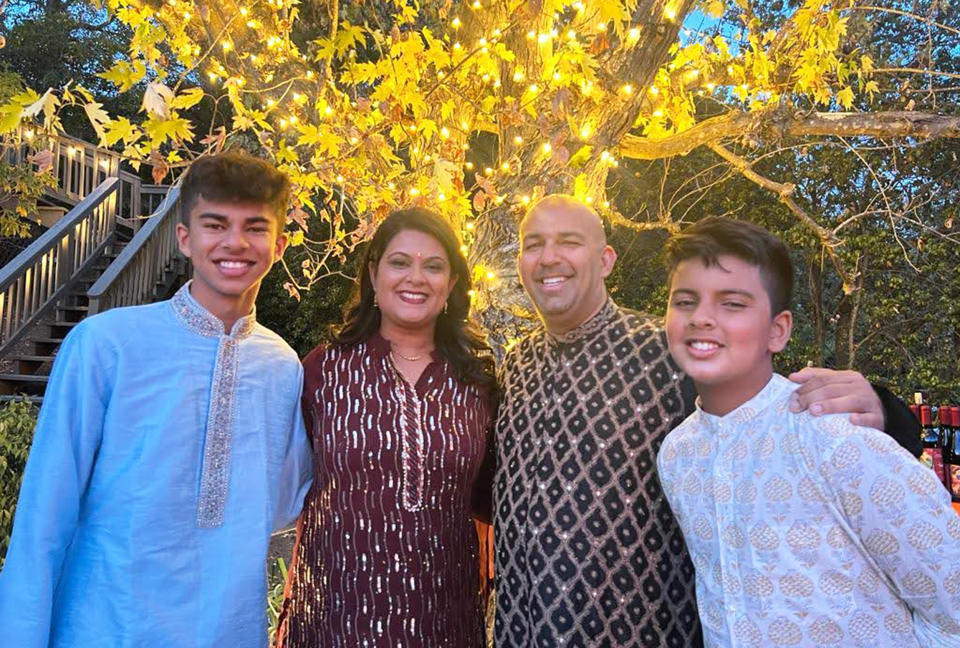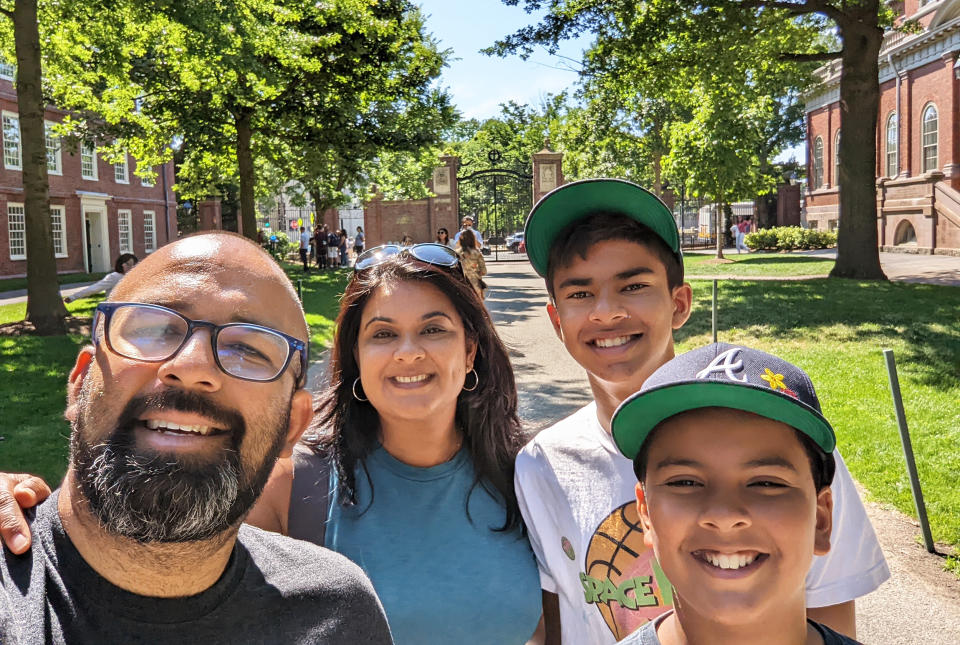Dad diagnosed with Parkinson's at 45 shares 'shocking' first symptoms
When Vikas Chinnan began experiencing stiffness on his right side, he thought it was related to a viral infection he had in his spine as a child. After numerous tests and treatments failed to help, doctors began investigating other potential illnesses, and he was ultimately diagnosed with young onset Parkinson’s disease.
“I was very unfamiliar with Parkinson’s disease,” Chinnan, 46, of San Carlos, California, tells TODAY.com. “For me, it was such a relief ... having answers and knowing what I was dealing with.”
Stiffness on right side, tremors
When Chinnan was in seventh grade, he contracted a viral infection of his spinal cord that impacted how he walked. So when, years later, he noticed he had less flexibility on his right side, he chalked it up to his past infection. Still, he went to a doctor, kicking off an investigation into his brain and spinal cord.
“For a while, I went through physical therapy. I saw lots of neurologists. I tried Botox and muscle relaxers,” he says. “Between my age and my medical history, there was a misdirect for several years.”
As Chinnan sought answers, he began developing new symptoms, including tremors in his right arm, cognitive impairment and apathy — signaling to his doctors that the problem might be neurological. He was also diagnosed with depression.

“That led my doctors to say, ‘Let’s at least explore Parkinson’s as a possibility,’ even though they were skeptical that that’s what it was given my age," he recalls.In some ways, being diagnosed with young onset Parkinson’s disease (when someone is diagnosed before age 50) in 2022 felt like a relief.
“I had been searching for an answer for so long, and I had really hit a wall with my physical therapy and the meds that I was trying,” he says. “I was just exhausted.”
The symptoms Chinnan had been experiencing had kept him out of work, and as soon as he was diagnosed, he could start various treatments. He met with a neural movement disorder specialist and began Rock Steady Boxing, a type of no-contact sparring that can help Parkinson’s patients manage their symptoms.
“I attacked it head on. I was open with my family about it,” he says. “I had already started seeing a therapist because of the cognitive and emotional things that I was dealing with.”
After his diagnosis, he learned a cousin also had Parkinson’s disease, which surprised him. His family member preferred keeping his illness quiet.
“I would say to anyone who gets diagnosed not necessarily that they need to be open and bless the world, but it’s really important to find their people, their network and their care team,” he says. “It’s not something that anyone should go through alone.”

Young onset Parkinson’s disease
Parkinson’s disease is a neurodegenerative condition that targets neurons that produce dopamine. It’s typically diagnosed after age 50, but about 5% of the total number of people diagnosed with Parkinson’s disease are diagnosed before 50.
“Young onset, it’s rare,” James Beck, Ph.D., chief scientific officer of the Parkinson’s Foundation, tells TODAY.com. “The numbers are hard to come by simply because we don’t have a comprehensive way of tracking who’s getting diagnosed with Parkinson’s disease, yet.”
The symptoms of Parkinson’s are generally the same regardless of age at diagnosis, but "one of the key symptoms for young onset Parkinson's disease" is more involuntary muscle contractions, also known as dystonia, Beck says. “Like a bad writer’s cramp ... bad feet cramps. Those are often early signs.”
Dystonia can occur unrelated to Parkinson’s, he adds, so doctors might misdiagnose younger people at first.
Other commons symptoms of young onset Parkinson's disease include pain in the joints, especially the shoulder, stiffness, slowness of movement and dyskinesia, or “uncontrolled movements," Beck explains.
Dyskinesia often occurs as a result of medications that Parkinson's patients may be taking. Constipation and sleep problems are also frequent in young onset patients, but they are often attributed to other causes.
Like Chinnan, a lot of patients receive a depression diagnosis before the Parkinson’s diagnosis, regardless of their age, which is likely due to the changes that occur in the brain with Parkinson’s.
“It’s an indication that changes in the brain ... are more widespread than just the movement,” Beck says. “It’s not just about getting a terrible diagnosis that can lead to someone being depressed. … It’s the disease process itself that’s leading to these chemical changes that can contribute to depression.”
Beck notes that the Parkinson’s Foundation conducted a registry to see how often Parkinson's patients receive mental health treatment. The findings indicate that the majority of patients do not.
“Only a small percentage of individuals are getting referred to mental health professionals,” he says. “Meanwhile, 40% of people get referred to a physical therapist. So one of the things we see as an organization that is … depression is something that’s not really routinely screened for, and we think that’s one of the issues for people getting the treatment they can really benefit from.”

Grappling with invisible symptoms
Chinnan experiences depression and apathy as part of his condition, and sometimes these invisible symptoms feel tough to navigate. Before he received his diagnosis, he started taking “epic” naps for two to three hours a day, where he would have very vivid dreams that he thought were real, he recalls, adding that he often forgot important things, such as the death of a friend’s dad.
“Even now that I’m on medication, I experience periods where I have this brain fog," he says.
He felt particularly stunned by his mental health symptoms, his apathy in particular because he thinks it's much less understood than depression. He went from being an extrovert that loved social activities to someone who often feels indifferent about many things.
“I find myself in situations where I don’t enjoy those things that I previously enjoyed,” he says. “That was really unnerving. It’s unsettling for my wife because she didn’t know that side of me.”
Chinnan says maintaining a low-stress level allows him to box, visit his doctors and rest when needed, which bolsters his health and reduces his symptoms.
“My hope is to be a resource to people that are experiencing (depression and apathy) and to help fight the hidden symptoms and to give people the hope that they can fight,” he says.
This article was originally published on TODAY.com

